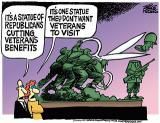Substantial numbers of low-income veterans are among those who would be affected by the legislation. Census data indicate that approximately 900,000 veterans receive SNAP assistance each month. (This figure is almost surely understated, because Census data do not capture SNAP receipt by homeless veterans — who, like most other homeless individuals aren’t included in the Census survey — and understate the overall number of people receiving SNAP.)
An estimated 170,000 of those 900,000 veterans could be affected by the two provisions of the House proposal that would place food assistance for jobless workers at risk.
The first of these, the “Southerland” provision, would encourage states to terminate assistance to non-elderly jobless adults (and their families) who do not find work or an opening in a workfare or job training program. According to the Census data, about 120,000 veterans could be at risk of losing SNAP under this provision. The second is the provision that would require states to terminate food aid after three months to unemployed people aged 18 to 50 not raising minor children who live in areas of high unemployment and cannot find a job or a place in a work or job training program. According to the Census data, about 50,000 veterans could be at risk of losing SNAP under this provision.
Other cuts in the bill, including the “categorical eligibility” cut targeted at low-income working families with high housing or child care costs (described below), could affect additional veterans and their families. read more>>>
























No comments:
Post a Comment